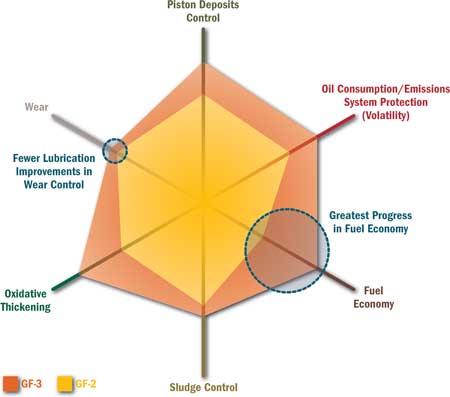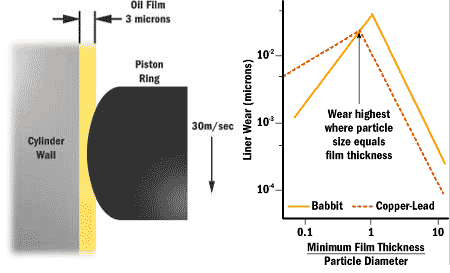There are many ways that a lubricant could fail to deliver fuel-efficient engine performance. Many of these are due to formulation issues as opposed to transient properties of the lubricant in service. For instance, there were significant advances in energy conservation when switching from GF-2 to GF-3 (international quality designation for gasoline engine lubricants) in 2001 (Figure 1).

Figure 1. GF-3 and GF-2 Comparison Diagram
When a lubricant degrades, it forms reaction products that become insoluble and corrosive. So too, the original properties of lubricity and dispersancy can become impaired as the lubricant ages and additives deplete. Much has been published about the risks associated with overextended oil drains and the buildup of carbon insolubles from combustion blow-by.
However, surprisingly little has been said about the impact of fine abrasives in a lube oil as it relates to fuel economy over the engine’s life. One can imagine numerous scenarios in which solid abrasives suspended in the oil could diminish optimum energy performance. Below is a list of several scenarios:
Antiwear Additive Depletion
High soot load of crankcase lubricants has been reported to impair the performance of ZDDP antiwear additives. Some researchers believe that soot and dust particles exhibit polar absorbencies, and as such, can tie-up the AW additive and diminish its ability to control friction in boundary contacts (cam nose, ring/ liner, etc.).
Combustion Efficiency Losses
Sooner or later, wear from abrasive particles and deposits from carbon and oxide insolubles will interfere with efficient combustion in an engine. Valve train wear (cams, valve guides, etc.) can impact timing and valve movement. Wear of rings, pistons and liners influences volumetric compression efficiency and combustion blow-by resulting in power loss.
As has been previously reported in this magazine, particle-induced wear is greatest when the particle sizes are in the same range as the oil film thickness (Figure 2). For diesel and gasoline engines, there are a surprising number of laboratory and field studies that report the need to control particles below ten microns. One such study by GM concluded that, “controlling particles in the 3 to 10 micron range had the greatest impact on wear rates and that engine wear rates correlated directly to the dust concentration levels in the sump.”1
Frictional Losses
When hard clear- ance-size particles disrupt oil films, including boundary chemical films, increased friction and wear will occur. One researcher reports that 40 to 50 percent of the friction losses of an engine are attributable to the ring/cylinder contacts, with two-thirds of the loss assigned to the upper compression ring.2
It has been documented that there is an extremely high level of sensitivity at the ring-to-cylinder zone of the engine to both oil- and air-borne contaminants. Hence, abrasive wear of the ring/cylinder area of the engine translates directly to increased friction, blow-by, compression losses and reduced fuel economy.
Viscosity Churning Losses
Wear particles contribute to oxidative thickening of aged oil. High soot load and/or lack of soot dispersancy can also have a large impact on oil viscosity increases. Viscosity-related internal fluid friction not only increases fuel consumption but also generates more heat that can lead to premature degradation of additives and base oil oxidation.
Stiction Losses. Deposits in the combustion chamber and valve area can lead to restriction movements in rings and valve control. When hard particle contamination agglomerates with soot and sludge to form adherent deposits between valves and guides, a tenacious interference, called stiction, results. Stiction causes power loss.
It causes the timing of the port openings and closings to vary, leading to incomplete combustion and risk of backfiring. Advanced phases of this problem can lead to a burned valve seat.2



Figure 3. Cummins N-14 (430E) Engines
Power Losses from Wear of Cummins Engines
Figure 3 shows an example of how increased engine wear, in this case due to overextended oil drains, contributes to power loss in the engine. At 2100 rpm, the severely worn engine horsepower at the wheels decreased from 365 hp to less than 300 hp (18 percent). Loss of horsepower translates directly to losses in fuel economy.3

A bus engine fuel consumption study by G. Andrews, et al. of the University of Leeds (Table 1), provides evidence of the benefit associated with cleaner oil on fuel economy in an actual road trial.4 It was noted that the Cummins engine’s fuel efficiency increased 2 percent to 3 percent when a six-micron by-pass filter was used along with a full flow filter.
The study spanned 50,000 miles of service. The fuel consumption was calculated based on detailed fuelling records from the fleet. In a similar study reported by the same authors using by-pass filtration, a 5 percent to 8 percent reduction in fuel consumption was achieved on a 1.8 liter Ford passenger car IDI diesel engine.
A study reported by J. Fodor and F. Ling of the Research Institute of Automotive Industry-Budapest and published in Lubrication Engineering magazine (Table 2) found a sharp improvement in fuel economy in a six-cylinder diesel engine fitted with improved filtration. By reducing oil contamination by 98 percent, not only was a nearly 5 percent reduction in fuel consumption achieved but wear and friction were reduced by 93 percent and 2.9 percent respectively.5
Waste Stream Emissions
When the engine consumes oil, due primarily to contaminant-induced wear, oil enters the combustion chamber, burns with the fuel, and is pushed out with exhaust gases as particles and volatile hydrocarbons. New mineral-based lubricants have a more volatile light-end fraction and are more prone to hydrocarbon emissions.
The level of exhaust emissions increases considerably over time corresponding to engine wear and deposit formation in the combustion zone. This leads not only to greater concentration of exhaust particulates, but also to a higher percentage that are unburned hydrocarbon, a by-product of oil consumption.

Figure 4. Off-road/tractor Particulate Emissions Predictions
Unlike a new engine, the lubricating oil is a dominant contributor to particulate matter (PM) emissions in aged engines. The obvious strategy to control/reduce hydrocarbon emissions is to reduce oil consumption. This, of course, points to a strategy of reducing abrasion and wear. According to projections by Barris of Donaldson Co. (Figure 4), after 12,000 hours of service, an off-road diesel engine can produce nearly six times more exhaust emissions due to wear associated with particles and other causes.6
Crankcase Oil Particle Counts
Good environmental stewardship is everyone’s responsibility. We all benefit from cleaner air and a safer environment. In addition, the financial impact that comes from reduced fuel consumption alone can be substantial. Perhaps it’s time for OEMs and users alike to begin revisiting contamination control practices, including filtration, associated with internal combustion engines.
If clean oil is important to control wear, reduce fuel consumption and emissions, perhaps it’s also time for users to begin asking their laboratories to begin reporting particle counts and ISO Codes of used crankcase oils. Remember, if it’s important, we measure it - correctly. What gets measured gets done.
References
- Staley, D.R. (1988). "Correlating Lube Oil Filtration Efficiencies with Engine Wear". SAE Truck and Bus Meeting and Exposition (Paper 881825).
- Madhavan, P.V. and Needelman, W.M. (1988). "Review of Lubricant Contamination and Diesel Engine Wear". SAE Truck and Bus Meeting and Exposition (Paper 881827).
- McGeehan, J. (2001, September-October). Uncovering the Problems with Extended Oil Drains. Machinery Lubrication magazine (www.machinerylubrication.com), pp. 24-29.
- Andrews, G.E., Li, H., Jones, M.H., Hall, J. Rahman, A.A. and Saydali, S. (2000). "The Influence of an Oil Recycler on Lubricating Oil Quality with Oil Age for a Bus Using In-Service Testing". SAE 2000 World Congress (Paper 2000-01-0234).
- Foder, J. and Ling, F.F. (1985, October). Friction Reduction in an IC Engine through Improved Filtration and a New Lubricant Additive. "Lubrication Engineering". pp. 614-618.
- Barris, M.A. (1995). "Total Filtration: The Influence of Filter Selection on Engine Wear, Emissions and Performance". SAE Fuels and Lubricants (Paper 952557).


.jpeg)


_small.jpeg)